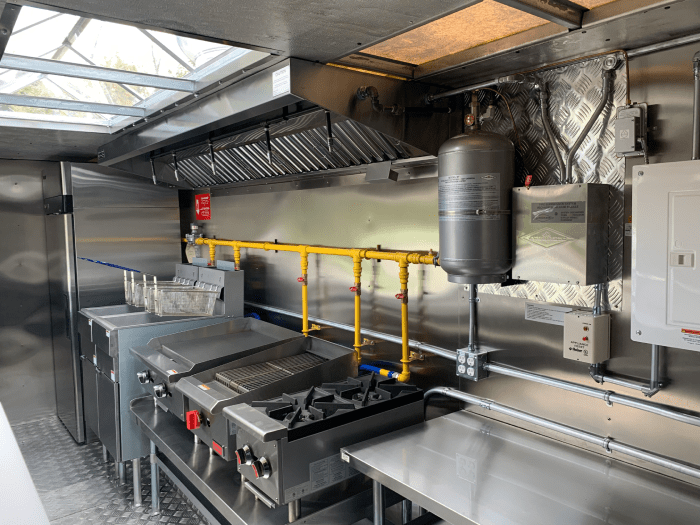How to write a killer food truck marketing plan
How to write a killer food truck marketing plan
Where’s the best place to start when you are developing a marketing plan? Define your target market clearly. Can I afford social media exposure? Do food trucks still use print marketing?
A comprehensive guide on food truck marketing was made to answer these questions. Browse our collection to find all the ideas, tips, and trends we have to offer.
How can a food truck business understand its target audience?
Demand for food trucks increased dramatically in 2020, resulting in an increase of 7.5% in business. Even though demand has increased, it does not mean that every customer wants your food truck or menu. Food trucks won’t be able to attract everyone to them; it isn’t worth trying.
Target markets for food trucks depend largely on their location and concept. Knowing that your marketing strategy has some analytical foundation can ease the minds of some business owners who find identifying their audience more science than creativity.
The general food market audience can be summarized as follows:
- Food truck customers comprise 47% of the millennial generation
- 80% of food truck diners are attracted by unique experiences and new food.
- The convenience, quality, and speed of food trucks will continue to draw diners.
The next step is to find your target audience! If you’re a food truck, you’re already in a niche, but you need to dig a little deeper. To figure out exactly (and I mean EXACTLY), who your target audience is, follow these steps:
Specifically: Identify your customers’ common characteristics and interests if you have any. Your food truck business plan should include a review of your competition. Are there niches that your competitors are ignoring? Who are they targeting?
The second is. Examine important demographic factors. In marketing, it can seem overly logical or disconnected, but it’s extremely useful.
In order for your marketing strategy to be effective, you should consider these seven factors:
The majority of diner patrons are millennials, but you might also attract older customers.
● Location – In which areas will you serve? The uptown area, the downtown area, or the residential area? What is the population in this area like?
In what category do you fall – upscale or economical? Do you have to spend extra for add-ons or are you on a budget?
If you have children, do you need a kid’s menu? Would couple’s entrees be appropriate?
Outdoor work culture is characterized by the use of food trucks. In what fields do you plan to work?
● Ethnicity – Will you serve ethnic comfort food or something unusual to people from different backgrounds?
Are your customers interested in food truck dining because it’s convenient or because they’re looking for a specific experience?
The third. Take into consideration the psychological characteristics of your customers.
Do you know what makes your ideal customers tick? Consider the following:
Characteristics of the individual
● Values
● Lifestyle
● Shopping or spending behavior
● Attitude
● Interests and hobbies
Creating customer personas around psychological factors may seem a bit excessive, but businesses often dedicate their time to doing just that.
Hercules, Deathstroke, and Starlord are among famous superheroes and villains on Hero or Villain, a Detroit-based sandwich truck. Customer interests and the concept drive their marketing.
Every quarter, consider running a customer analysis for the food truck marketing plan. By analyzing your target platforms, you can ensure that you are engaging your audience and not overlooking key contact points.
What to include in a food truck marketing budget
Owners of small businesses want to understand: how much will this cost? The budget size does not predict if a campaign will be successful, nor will a larger budget. If you spend a lot on content creation, then you can upload a blog post every day, but that doesn’t guarantee traffic or conversions.
A rule of thumb that food truckers have used for years is recognized in Mobile Cuisine. Marketing costs should be between 3 and 6% of sales.
You can get a lot done with a bootstrapped budget, even if you plan a food truck ad campaign. Based on recent sales figures, create an annual budget for marketing your food truck. Next, determine which channels you want to spend on for print, social media, events, and other digital marketing.
This is the structure of your food truck marketing plan
If you don’t have a plan in place, food truck marketing can feel like you are wasting your time and money. Make sure your plan targets both your offline and online audiences and helps you draw people in to keep your truck busy.
Food truck branding recommendations
It’s all about branding these days. It seems like everything is about branding these days. Marketing campaigns are based on the foundation of a good business. How would you describe your brand? Your brand is made up of a logo, a name, values, aesthetics, and presence.
In your logo or name, you will already have some of your values and aesthetics reflected. As an example, I gave earlier the example of Heroes and Villains. Their names tell the whole story. As for their aesthetic, it is based on the pop-art style of traditional comics. Every marketing campaign uses all of these elements, and it produces a certain level of trust, loyalty, and familiarity.
To build a strong brand, follow these tips:
Consistently follow these steps! Be consistent.
Keep a consistent visual identity – use the same font, color palette, and logo everywhere.
Put together a tagline – a three- to five-word summary or declaration of what you do and why you’re great!
Do you need some inspiration for your tagline? One of Dollar Shave Club’s slogans is to “Shave time. Shave Money.” As for M&M’s famous slogan, “Melt in your mouth, not in your hands.”
Promoting food trucks online
Our next round of data will show continued growth as people learn how to control their search results better as they learn more about “near me” and “where to buy”. It’s hard to keep up with everything that falls under the digital marketing umbrella.
It is not necessary to be an expert in digital marketing to get started. There is a lot of information and new terminology to keep up with. We will talk about how to improve brand loyalty, social media presence, and apps.
Your food truck website
There are several decent services available to simplify the process of developing a website. Having a website that looks good isn’t the only concern when it comes to using Squarespace and Wix. Don’t overthink it. Websites are not (as a rule) carved from living stone, so they are easy to edit change revise and overhaul. Get a phase one version out there.
Quick!
When designing a marketing plan for a food truck, make sure to:
Keep your site’s page speed high by not loading large video files. Visitors are impatient when it comes to page loading times. You’ll lose quite a few visitors if your page doesn’t load in a few seconds.
Keep all of your marketing materials and your website consistent.
You should target SEO (Search Engine Optimization) – phrases and keywords that your audience is likely to use when searching for a food truck.
● Google Adwords – a tool for researching SEO keywords and buying them for Google promoted results (ads).
In addition to existing online, your website will do a lot more for you. To make your website more effective, here are a few tips:
Post meaningful content on your site by hosting a blog. Post things related to your brand and business that people want to read, rather than posting on a daily basis.
You can use email marketing to build a list of email subscribers on your website! Provide information about your locations, coupons, and loyalty club information in your newsletters.
Connect with influencers to boost traffic to your site and grow your email list. This will help you reach out to more of your target audience.
Social media marketing for food trucks: best practices
A food truck social media campaign can help you reach out to your target market and cover a lot of ground. Here are some good social media marketing practices for food trucks:
Using various channels like Instagram, YouTube, and Twitter will help you reach your target audience. Concentrate your efforts in the direction where your target audience gravitates.
Regular posts should include information about your location, menu changes, and upcoming events.
Promote campaigns using paid ads and other methods to encourage engagement, such as hosting a raffle or giveaway on Instagram or Facebook.
Online listings shouldn’t be ignored! Yelp! You can list your business online using Google My Business, LinkedIn Company Directory, Apple Maps, and Bing or Yahoo. Provide your contact information with these sites so people can get in touch with you at any time.
Engage your customers by responding to their questions and comments.
Consistently represent your brand on all platforms.
You should be using food truck apps everywhere!
On both sides, there are many apps for food trucks. There are a variety of apps available for processing payments, tracking shifts, etc. It’s on the apps where customers search for food trucks that you want to be!
Make sure your food truck is easily found by signing up with the following mobile apps:
● Roaming Hunger
● Food Truck Fiesta
● Eat St.
● TruxMap Lite Food Truck Map
● Road Stoves GPS
Branded loyalty programs and cards
A branded loyalty program for food trucks can be built through email marketing. Your customer base can also be used. Loyalty programs are a key component of your digital marketing strategy, but the costs are related to what you already spend on your POS.
You can make it easy for cashiers and guests to access loyalty program discounts and bonuses with an all-star Point-of-Sale system. By importing customer sign ups from your email list, Poster POS helps owners and management teams build customer bases right in the POS systems.
Consider the cost-effectiveness of your POS system
Coffee shops can benefit from Poster POS
Displaying posters at point of sale
Food truck marketing through print
There is still a place for print marketing. You can still attract customers with flyers, car wraps, and loyalty cards. Print marketing is not a thing to ignore, even though most of your food truck advertising happens online.
Print marketing for food trucks includes the following:
- Coupons on paper
- Loyalty stamps & punch cards
- Menus printed on paper
- Cards for business
- Informational brochures or flyers about catering
Offline events with a flair for your food truck
Is there anything you can do offline to engage customers and make a long-term impact on your food truck? Taste testings, prizes, and food truck festivals are just a few suggestions! It is possible to cultivate a following in your community in nearly countless ways.
The competition at food truck events can make it seem impossible to succeed. Food truck events are a chance to explore different food trucks and taste the food.
You can start hosting tasting sessions once you have tapped into your community’s food truck events and festivals. Taste tests have become increasingly popular, and they’re an excellent way to gain exposure at a low cost.
Many people can be reached through food truck festivals and tasting sessions. Just give them a taste! Many restaurants will cut down their menus or decrease portions (and their prices to match) in order to entice diners to try your food.
Partnering and cross-promotion ideas for food trucks
Connect with the right partners or brands based on your food truck customer demographics and learn more about your customers. Unlike many other businesses, food trucks are not necessarily directly competing with other businesses.
Cross-promotions and partnerships between food trucks can work in several ways. As a starting point, partners can look to partner with complimentary food trucks. Food trucks that serve loaded fries, for instance, might look into partnering with those that serve specialty lemonades and boba drinks. Neither would compete with the other, and both would benefit.
Partnering with local businesses and securing lunchtime availability is another way to make partnerships work. You can schedule parking days nearby by contacting local offices, construction companies, and auto repair shops. Scheduled parking days have the following benefits:
Your coworkers will be able to make lunch plans around your presence since they will be aware you are going to be there.
The lunch truck is an alternative to eating fast food elsewhere.
Due to the fact that employees won’t be driving off-site and then taking time to return, appearing on-site gives them more time to use their lunch break.
Food truck services that could be provided in additional ways
The food truck market is constantly changing. It is impossible to keep up with them, but you can integrate additional services into your operations.
Most in-door dining remained closed in the summer of 2020, even though most COVID-19 restrictions or guidelines were relaxed. Many cities do not allow food trucks either, even though they were a great solution for people when they needed something for a small group. What can be done? Small groups, outdoor weddings, and other outdoor events are catered by food trucks. There will always be busy and slow periods in the foodservice industry.
Having your other services available is always helpful when things are uncertain. Here are some steps you can easily take:
● Cater to private events
● Catering or service for corporate events
● Delivery services
● Merchandise
You can make a lot of money from merchandise, especially if you brand it. One of Singapore’s most famous coffee roasters, Five Oars Coffee Roasters, encourages all its customers to have the best coffee possible. Additionally, they sell coffee grinders, silicone drippers, and drinkware.
Here are some tips for choosing the right location for a food truck
You might not think of location marketing as a marketing effort at first, but people have to know where to go. By using local photos and geo-location hashtags in your marketing, you can help people understand when and where to find your truck. Consider the following tips to help you select the right location:
Keep an eye out for opportunities to stop near public parking lots or public transit stations.
Parking for food trucks should be available at the location.
Put your truck in areas where people walk a lot.
It is possible to accomplish everything listed here if you park on legendary Alameda Street in Los Angeles. In addition to zoning for food trucks, the street is close to a Metro station for Little Tokyo and Chinatown, and it is home to a number of landmarks.
Make sure you market your location once you have found the right one.
You can make your location more visible on social media by:
Uploading photos of your truck next to famous buildings or landmarks.
Add geolocation tags to your posts
Share a picture of the nearest cross-street
Attach screenshots of a navigation app that provides directions from the nearest major road, freeway, highway, or public transportation stop.
Food presentation should be a part of marketing
Advertising for food trucks is not effective until happy customers tell others about how good your food is. You may see plenty of photos of your food truck on social media if you use fun, fresh, or quirky presentations as part of your food truck advertising strategy. Whether it’s a food writer or a social media user, everyone is willing to share a photo of their food and drink.
Social media and the excitement of people who are sharing their food on social media are great ways to increase brand awareness. Make sure you use disposable malware with your brand name or logo. By doing so, your brand will almost certainly appear in every online image!
Develop a marketing plan for your food truck
If you plan to market a food truck, take your time. Focus on one campaign at a time or keep the scope within a 12-week timeframe. Remember that your menu shouldn’t be your only concern.
Food truck marketing plan templates are difficult to create since the concept, location, and target market can all have an impact on your marketing strategy. In order to help guide your approach to building your plan, you can use this rough outline:
- Establish a budget.
- Define your brand image clearly!
- Your target market should be identified (and located).
- Determine the following key points for digital marketing:
- Media on social networks
- Marketing via email
- Blog and website for food trucks
- A loyalty program or an app
- Plan and layout print advertisements:
- Flyers
- Coupons printed on paper
- Printed business cards
- Cards with loyalty stamps
- Events for offline marketing should be scheduled
- Join forces with other food trucks or businesses to cross-promote
- Your catering service, delivery service, and merchandise should be promoted.
- Be consistent with your branding and merchandise to keep your brand’s image going!
It takes time and effort to learn how to write a mobile food truck marketing strategy. If you want to stay busy, build a following, and have enjoyable and profitable events, then it is an important investment. Have fun developing your food truck marketing plan!




